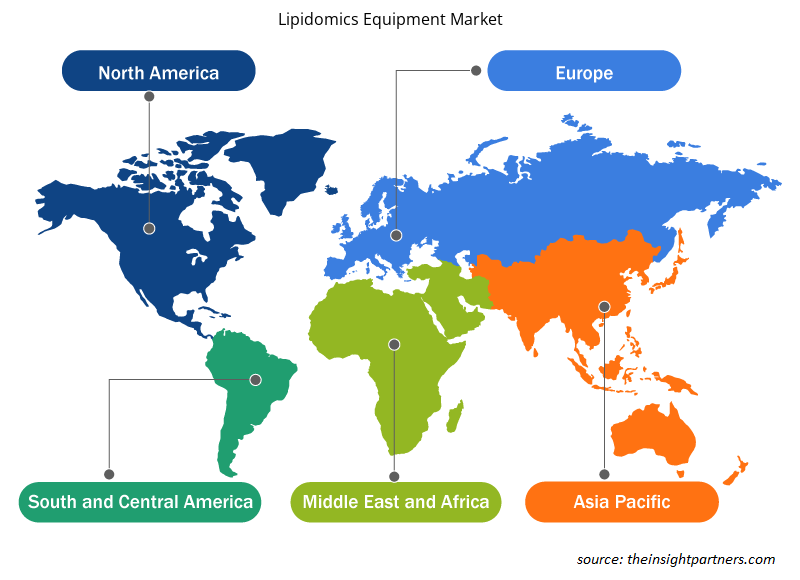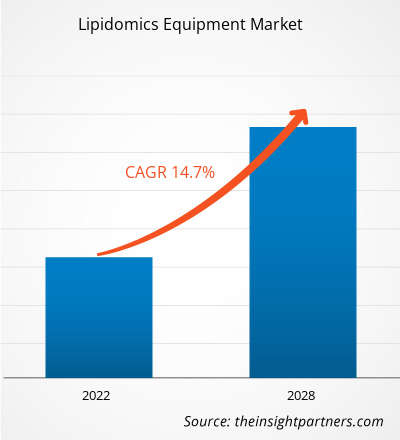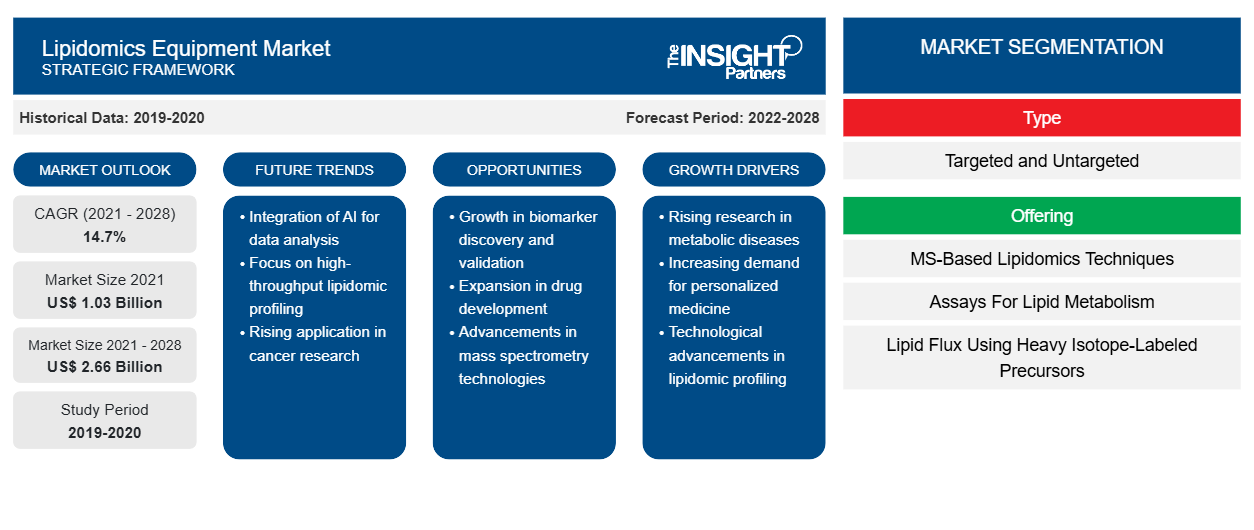Der Markt für Lipidomik-Geräte wurde im Jahr 2021 auf 1.025,38 Millionen US-Dollar geschätzt und dürfte von 2022 bis 2028 mit einer durchschnittlichen jährlichen Wachstumsrate von 14,7 % wachsen.lipidomics equipment market was valued at US$ 1,025.38 million in 2021 and it is expected to grow at a CAGR of 14.7% from 2022 to 2028.
Das Wachstum des Marktes ist auf die technologischen Fortschritte in der Massenspektrometrie und die zunehmende Anwendung der Lipidomik in den biomedizinischen Wissenschaften zurückzuführen. Allerdings schränken die hohen Produktpreise das Wachstum des Marktes für Lipidomik-Ausrüstung ein . Die Lipidomik, eine aufstrebende Disziplin der biomedizinischen Wissenschaften, umfasst die Charakterisierung komplexer Lipidome. Die Lipidom-Charakterisierung basiert auf einer Quantifizierung auf Systemebene und der Erkennung mehrerer Netzwerke und Wege zellulärer Lipide sowie ihrer Interaktion mit anderen Einheiten und Proteinen. Der Bedarf an einer genauen Krankheitsdiagnose, die wachsende Nachfrage nach personalisierten Medikamenten, technologische Fortschritte in der Lipidomik und enorme Investitionen des öffentlichen und privaten Sektors in F&E-Aktivitäten werden das Marktwachstum im Prognosezeitraum weiter vorantreiben.
Passen Sie diesen Bericht Ihren Anforderungen an
Sie erhalten kostenlos individuelle Anpassungen an jedem Bericht, einschließlich Teilen dieses Berichts oder einer Analyse auf Länderebene, eines Excel-Datenpakets sowie tolle Angebote und Rabatte für Start-ups und Universitäten.
-
Holen Sie sich die wichtigsten Markttrends aus diesem Bericht.Dieses KOSTENLOSE Beispiel umfasst eine Datenanalyse von Markttrends bis hin zu Schätzungen und Prognosen.
Der asiatisch-pazifische Raum gilt als die am schnellsten wachsende Region auf dem globalen Markt für Lipidomik-Ausrüstung. China, Japan und Indien zählen zu den wichtigsten Marktteilnehmern in dieser Region. Investitionen internationaler Akteure in China und Indien, wachsende staatliche Unterstützung in den Ländern, florierende Kooperationen zwischen Forschungsorganisationen, eine steigende Zahl von Forschungsinstituten für Lipidomik-Ausrüstung und Fortschritte in der Gesundheitsinfrastruktur gehören zu den Schlüsselfaktoren, die den Markt für Lipidomik-Ausrüstung im asiatisch-pazifischen Raum ankurbeln.
Markteinblicke
Technologische Fortschritte in der Massenspektrometrie treiben das Wachstum des Marktes für Lipidomik-Geräte voran
Massenspektrometer werden häufig zur Identifizierung und Quantifizierung von Lipiden verwendet. Die hochenergetische kollisionsaktivierte Dissoziationstechnik (CAD) der Massenspektrometrie führt zu Charge Remote Fragmentation-Reaktionen (CRF), die dabei helfen, die Position kleiner struktureller Bindungsdetails zu ermitteln. Forschern und Technikern stehen mehrere fortschrittliche Massenspektrometer zur Verfügung, darunter Sektormassenspektrometrie, Matrix-unterstützte Laserdesorptions-Ionisations-Flugzeitmessung (MALDI-TOF), Flüssigkeitschromatographie-Massenspektrometrie (LC-MS) und Tandem-Massenspektrometer. Darüber hinaus werden diese Instrumente mit Automatisierung, Miniaturisierung, künstlicher Intelligenz (KI) und intelligenten Technologien integriert, um ihre Effizienz und Genauigkeit zu verbessern.collisional-activated dissociation (CAD) technique of mass spectrometry results in charge remote fragmentation (CRF) reactions, which help detect the location of small structural bond details. Several advanced spectrometry, matrix-assisted laser desorption ionization-time-of-flight (MALDI-TOF), liquid chromatography-mass spectrometry (LC-MS), and tandem mass spectrometer have been made available for researchers and technicians. Further, these instruments are being integrated with automation, miniaturization, artificial intelligence (AI), and smart technologies to enhance their efficiencies and accuracies.
Im Jahr 2018 brachte Thermo Scientific das UV/Vis-Spektrometer Genesys 50 auf den Markt, das eine Einzelzellenkonfiguration aufweist, die für geringe Probendurchsatzanforderungen geeignet ist und über ein abnehmbares, waschbares Probenfach zur einfachen Reinigung verfügt. Im selben Jahr brachte Shimadzu in Zusammenarbeit mit PREMIER Biosoft das LCMS-9030 Quadrupole Time of Flight (Q-TOF)-Massenspektrometriesystem (MS) von Shimadzu für die Lipidomik- und Glykomik- Datenanalyse auf den Markt. Das Produkt verfügt über Informatikunterstützung durch Softwarelösungen von PREMIER Biosoft. Im Jahr 2019 stellte TTP Venus Ltd eine Reihe neuer Mikropumpen mit verbesserter Leistung, höheren Durchflussraten, hohem Druck und längerer Lebensdauer vor. Die Einführung dieser neuen verbesserten Massenspektrometer und Mikropumpen fördert das Wachstum des Marktes für Lipidomik-Geräte.Thermo Scientific launched Genesys 50 UV/vis spectrometer that has a single cell configuration, which is suitable for low sample throughput needs, with a removable, washable sampling compartment for easy clean-up. In the same year, Shimadzu, in collaboration with PREMIER Biosoft, launched Shimadzu's LCMS-9030 Quadrupole Time of Flight (Q-TOF) mass spectrometry (MS) system for lipidomics and Biosoft. In 2019, TTP Venus Ltd introduced a range of new micropumps with enhanced performance, higher flow rates, high pressures, and longer life. The introduction of such new enhanced mass spectrometers and micropumps is boosting the growth of the lipidomics equipment market.
Typbasierte Erkenntnisse
Der Markt für Lipidomik-Geräte wird nach Typ in zielgerichtete und nicht zielgerichtete Geräte unterteilt. Das zielgerichtete Segment hatte 2021 einen größeren Marktanteil und wird voraussichtlich zwischen 2021 und 2028 eine höhere durchschnittliche jährliche Wachstumsrate verzeichnen. Gezielte Lipidomik-Geräte werden hauptsächlich zur Analyse von Signalverarbeitungspfaden verwendet. Schnelle Fortschritte bei Techniken und deren Anwendungen können eine rechtzeitige Überprüfung dieser Aspekte unerlässlich machen.lipidomics equipment market is segmented into targeted and untargeted. The targeted segment held a larger share of the market in 2021, and it is anticipated to register a higher CAGR during 2021–2028. Targeted lipidomics equipment are mainly used for analyzing signal processing pathways. Rapid advancements in techniques and their applications are capable of making a timely review of these aspects essential.
Angebotsbasierte Erkenntnisse
Basierend auf dem Angebot ist der Markt für Lipidomik-Geräte segmentiert in MS-basierte Lipidomik-Techniken, Tests für den Fettstoffwechsel, Lipidfluss unter Verwendung isotopenmarkierter Vorläufer, Software und Dienstleistungen und andere. Das Segment der MS-basierten Lipidomik-Techniken hatte 2021 den größten Marktanteil und wird im Prognosezeitraum voraussichtlich die höchste durchschnittliche jährliche Wachstumsrate (CAGR) auf dem Markt verzeichnen.
Servicebasierte Einblicke
Basierend auf dem Service ist der Markt für Lipidomik-Geräte segmentiert in Biomarker-Identifizierung, bioinformatische Analyse und Dateninterpretation, molekulare Analyse eines breiten Spektrums von Phospholipiden (Lipid-Fingerprinting), Analyse und Identifizierung ungewöhnlicher Lipide, semiquantitative und quantitative Analyse, Lipidflussstudien und andere. Das Segment der Biomarker-Identifizierung hatte 2021 den größten Marktanteil und wird im Prognosezeitraum voraussichtlich die höchste CAGR verzeichnen. Die Biomarker-Identifizierung ist die am weitesten verbreitete Methode zur Diagnose chronischer Krankheiten wie Krebs und Nierenerkrankungen.lipidomics equipment market is segmented into biomarker identification, bioinformatic analysis & data interpretation, molecular analysis of a broad spectrum of phospholipids (lipid fingerprinting), analysis & identification of unusual lipids, semiquantitative & quantitative analysis, lipid flux studies, and others. The biomarker identification segment held the largest share of the market in 2021, and it is estimated to register the highest CAGR during the forecast period. Biomarker identification is the most widely used method for the diagnoses of chronic diseases, such as cancer and kidney disorders.
Endbenutzerbasierte Erkenntnisse
Basierend auf dem Endverbraucher ist der Markt für Lipidomik-Ausrüstung in die Bereiche Molekularforschung, Zellforschung, klinische Forschung, Gewebe- und Organforschung, Datenforschung, Organismusforschung, technische Dienste und Prototyping, Produktion und andere unterteilt. Das Segment Molekularforschung hatte im Jahr 2021 den größten Marktanteil und wird im Prognosezeitraum voraussichtlich die höchste durchschnittliche jährliche Wachstumsrate verzeichnen.
Unternehmen, die auf dem Markt für Lipidomik-Ausrüstung tätig sind, verfolgen eine Strategie der Produktinnovation, um den sich entwickelnden Kundenanforderungen weltweit gerecht zu werden und so ihren Markennamen auf dem Weltmarkt zu behaupten.
Regionale Einblicke in den Markt für Lipidomik-Geräte
Die regionalen Trends und Faktoren, die den Markt für Lipidomik-Ausrüstung während des gesamten Prognosezeitraums beeinflussen, wurden von den Analysten von Insight Partners ausführlich erläutert. In diesem Abschnitt werden auch die Marktsegmente und die Geografie für Lipidomik-Ausrüstung in Nordamerika, Europa, im asiatisch-pazifischen Raum, im Nahen Osten und Afrika sowie in Süd- und Mittelamerika erörtert.

- Erhalten Sie regionale Daten zum Markt für Lipidomik-Geräte
Umfang des Marktberichts zu Lipidomik-Geräten
| Berichtsattribut | Details |
|---|---|
| Marktgröße im Jahr 2021 | 1,03 Milliarden US-Dollar |
| Marktgröße bis 2028 | 2,66 Milliarden US-Dollar |
| Globale CAGR (2021 - 2028) | 14,7 % |
| Historische Daten | 2019-2020 |
| Prognosezeitraum | 2022–2028 |
| Abgedeckte Segmente |
Nach Typ
|
| Abgedeckte Regionen und Länder |
Nordamerika
|
| Marktführer und wichtige Unternehmensprofile |
|
Dichte der Marktteilnehmer für Lipidomik-Ausrüstung: Die Auswirkungen auf die Geschäftsdynamik verstehen
Der Markt für Lipidomik-Ausrüstung wächst rasant, angetrieben durch die steigende Nachfrage der Endnutzer aufgrund von Faktoren wie sich entwickelnden Verbraucherpräferenzen, technologischen Fortschritten und einem größeren Bewusstsein für die Vorteile des Produkts. Mit steigender Nachfrage erweitern Unternehmen ihr Angebot, entwickeln Innovationen, um die Bedürfnisse der Verbraucher zu erfüllen, und nutzen neue Trends, was das Marktwachstum weiter ankurbelt.
Die Marktteilnehmerdichte bezieht sich auf die Verteilung der Firmen oder Unternehmen, die in einem bestimmten Markt oder einer bestimmten Branche tätig sind. Sie gibt an, wie viele Wettbewerber (Marktteilnehmer) in einem bestimmten Marktraum im Verhältnis zu seiner Größe oder seinem gesamten Marktwert präsent sind.
Die wichtigsten auf dem Markt für Lipidomik-Ausrüstung tätigen Unternehmen sind:
- Thermofisher Scientific
- Kreative Proteomik
- Ionenbank
- Shimadzu Europe GmbH
- Bruker
Haftungsausschluss : Die oben aufgeführten Unternehmen sind nicht in einer bestimmten Reihenfolge aufgeführt.

- Überblick über die wichtigsten Akteure auf dem Markt für Lipidomik-Ausrüstung
Markt für Lipidomik-Geräte: Segmentübersicht
- Der Markt für Lipidomik-Geräte wird nach Typ in zielgerichtete und nicht zielgerichtete Geräte unterteilt. Im Jahr 2021 hatte das zielgerichtete Segment einen größeren Marktanteil; für das nicht zielgerichtete Segment wird jedoch von 2022 bis 2028 eine höhere durchschnittliche jährliche Wachstumsrate erwartet.
- Basierend auf dem Angebot ist der Markt für Lipidomik-Ausrüstung segmentiert in MS-basierte Lipidomik-Techniken, Tests für den Lipidstoffwechsel, Lipidfluss unter Verwendung schwerer Isotopen-markierter Vorläufer, Software & Dienstleistungen und andere. Das Segment der MS-basierten Lipidomik-Techniken ist weiter segmentiert in Massenspektrometer, die mit Ionenquellen (Turbo-) ESI/Nano-ESI/APCI, Autosampler, Mikropumpen, UV-Detektoren, UPLC, Fluoreszenzdetektoren mit variabler Länge und andere ausgestattet sind. Das Segment der MS-basierten Lipidomik-Techniken hatte 2021 den größten Marktanteil; jedoch wird erwartet, dass das Segment Software & Dienstleistungen im Prognosezeitraum die höchste CAGR verzeichnen wird.
- Basierend auf dem Service ist der Markt für Lipidomik-Geräte segmentiert in Biomarker-Identifizierung, bioinformatische Analyse und Dateninterpretation, molekulare Analyse eines breiten Spektrums von Phospholipiden (Lipid-Fingerprinting), Analyse und Identifizierung ungewöhnlicher Lipide, semiquantitative und quantitative Analyse, Lipidflussstudien und andere. Das Segment Biomarker-Identifizierung hatte 2021 den größten Marktanteil; jedoch wird erwartet, dass das Segment bioinformatische Analyse und Dateninterpretation im Prognosezeitraum die höchste durchschnittliche jährliche Wachstumsrate verzeichnet.
- Basierend auf dem Endverbraucher ist der Markt für Lipidomik-Geräte in die Bereiche Molekularforschung, Zellforschung, klinische Forschung, Gewebe- und Organforschung, Datenforschung, Organismusforschung, technische Dienste und Prototyping, Produktion und andere unterteilt. Das Segment Molekularforschung hatte 2021 den größten Marktanteil; jedoch wird erwartet, dass das Segment klinische Forschung im Prognosezeitraum die höchste durchschnittliche jährliche Wachstumsrate verzeichnet.
Markt für Lipidomik-Ausrüstung: Wettbewerbslandschaft und wichtige Entwicklungen
Zum Markt für Lipidomik-Ausrüstung gehören Thermofisher Scientific, Creative Proteomics, IonBench, Shimadzu Europe GMbH, Bruker, Agilent Technologies Inc, PerkinElmer, Inc., Sciex, Metabolon, Inc. und Cayman Chemical. Diese Akteure konzentrieren sich auf die Expansion, Diversifizierung ihrer Marktpräsenz und den Aufbau eines neuen Kundenstamms, um so bestehende Geschäftsmöglichkeiten zu nutzen.
- Historische Analyse (2 Jahre), Basisjahr, Prognose (7 Jahre) mit CAGR
- PEST- und SWOT-Analyse
- Marktgröße Wert/Volumen – Global, Regional, Land
- Branchen- und Wettbewerbslandschaft
- Excel-Datensatz
Aktuelle Berichte
Erfahrungsberichte
Grund zum Kauf
- Fundierte Entscheidungsfindung
- Marktdynamik verstehen
- Wettbewerbsanalyse
- Kundeneinblicke
- Marktprognosen
- Risikominimierung
- Strategische Planung
- Investitionsbegründung
- Identifizierung neuer Märkte
- Verbesserung von Marketingstrategien
- Steigerung der Betriebseffizienz
- Anpassung an regulatorische Trends























 Kostenlose Probe anfordern für - Markt für Lipidomik-Geräte
Kostenlose Probe anfordern für - Markt für Lipidomik-Geräte